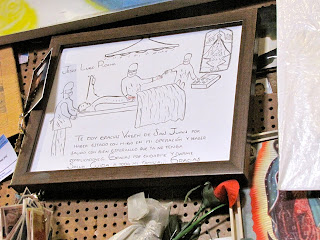Here's a short list of what to see when you travel here.
Museo de las Momias/the Mummy Museum. These are not neatly wrapped, beautifully packaged Egyptian mummies, but accidental mummies. Dead people whose families could not, would not or were no longer around to pay for their departed's crypt space. Yes, there's a ick factor, but also fascination and a big dose of reality. Besides, everyone will want to know why you didn't see the mummies if you don't.
Tip: There are labels in Spanish and sometimes in English but get a guide who will tell you about the mummified corpses who range from newborn to seniors, rich to poor, peaceful to frightening.
You'll have to decide which is worse - the tourists who pulled of bits of mummified flesh for souvenirs (mummies are now safely behind plexiglass) or the prospect of looking like the mummies yourself. Fortunately, given the Mexican's light-hearted approach to death, vendors outside provide comic relief.
Tip: There's a nice banyo - 4 pesos - with an attendant who will make change.
Walk around the corner - slightly up hill - and you can see the cemetery where the mummies once resided.
Templo de Valenciana/Church of San Cayetano. Mexicans put the ultimate flourishes to Baroque architecture, known here as
Churrigueresque, especially those such as Don Antonio de Obregon y Alcocer who repaid God's letting him find gold, silver and becoming one of the richest, most powerful men in Mexico by building a church.
Tip: You definitely want to take a cab here and you will still have stairs to climb but it's worth the effort.
The facade is only a taste of what you'll see inside - 19th century paintings, enough gold gilt to make Midas jealous and incredibly detailed carving.
Tip: The basilica and all of the churches here are worth seeing. As you walk by them, slip in and rest a bit.
Diego Rivera House. The 18th century boyhood home of Mexico's renowned artist (who married one of its other renowned artists,
Frida Kahlo) is preserved as when the Rivera family lived there. In the upstairs galleries are more than 100 of Rivera's works spanning his creative development.
Warning: There are stairs but if you enjoy seeing how an artist progresses through various styles this is worth it.
Callejon de Beso/Kiss Alley. Just off the Plazuela de los Angeles, this narrow alley got its name from facing balconies a mere 27 inches apart and the romantic and tragic legend of the two lovers who lived near enough to kiss but too far away for a happy ending.
Mercado Hidalgo/Jardin Reforma. Everyone will tell you to visit the Hidalgo Market and it is worth a look, but I'd seen plenty of colorful displays of produce and flowers and other wares already.
Tip: The good stuff is upstairs.
More enjoyable was the garden square and fountain across the street where the market used to be.
Valenciana Mine. You can put on a hardhat and go down it if you want, but I preferred wandering the grounds and sipping a cold beverage in the open-air bar. Its storeroom, which once held dynamite, now is filled with tequila. As one wag said, "What's the difference? Both are dangerous."
Even better, the room dedicated to St. San Ramon Nonato. Legend has it if you don't like a neighbor, buy a lock and hang the key from the ceiling to shut their mouth. Don't know if it works but as you can see, a lot of people have given it a try.
Next, a memorable meal, what I wish I'd seen and suggestions for the flattest way to see Guanajuato.
Leia Mais…


















































